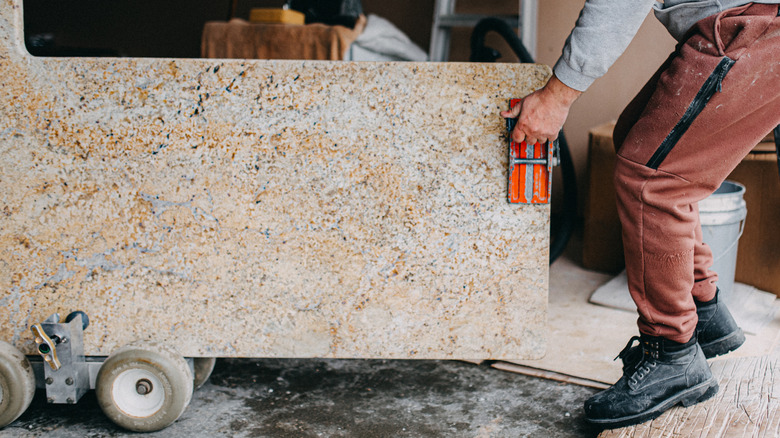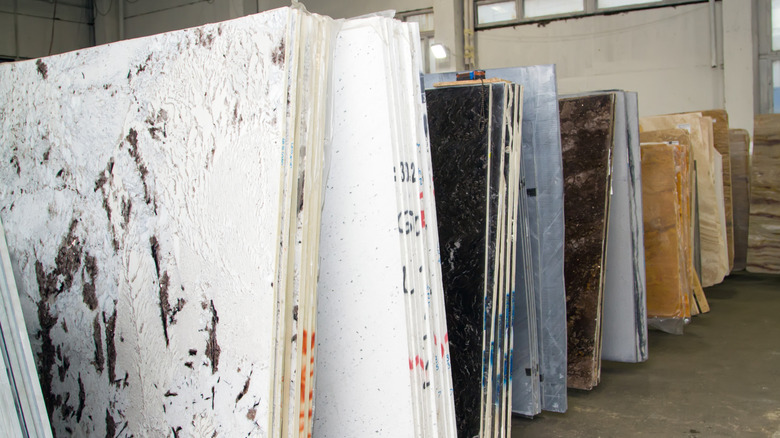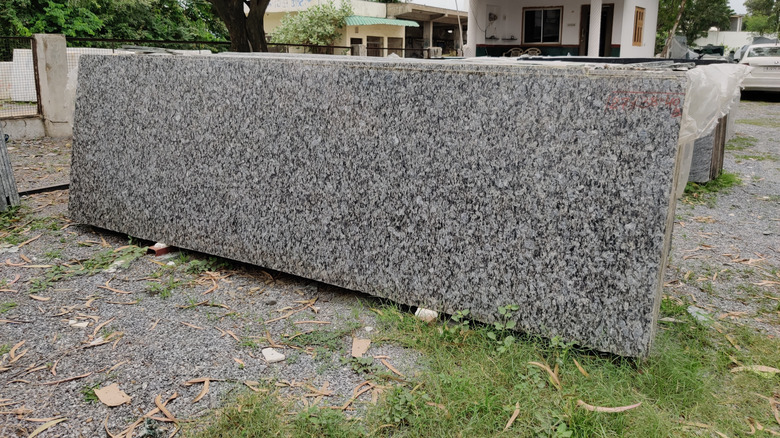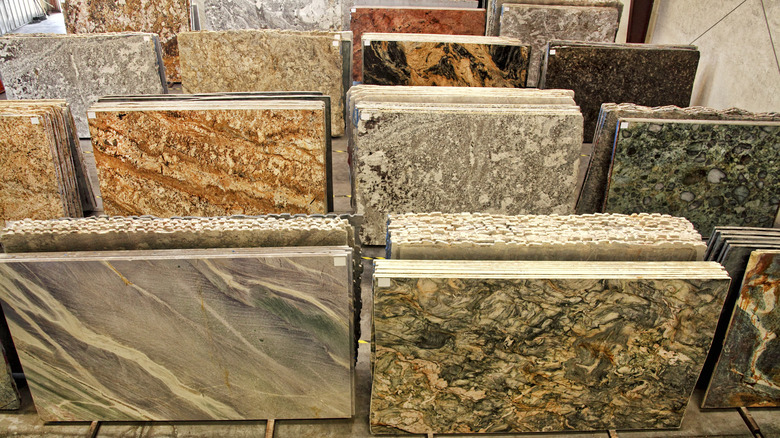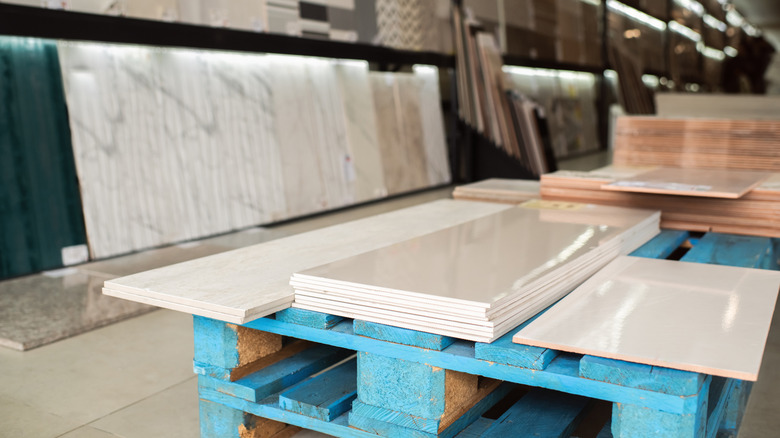Insider Tips For Buying Marble Or Stone Remnants Secondhand
There are many reasons you might be considering marble or other stone countertop materials for your kitchen. Stone countertops offer a nice mix of durability and aesthetic appeal. While marble is known for its elegance that can instantly give a kitchen a more luxurious look and feel, other materials, such as granite, are coveted for their durability and heat resistance. However, while there are several reasons you might want to choose stone countertops for your kitchen renovation project, there could be one important thing holding you back: the price. Marble is particularly expensive — you can easily pay $125 or more per square foot for the stone and installation. Other options, including granite and quartz, are more affordable, but can still cost $65 or more per square foot by the time you pay for the stone and installation.
Fortunately, there is one designer secret that might help you save money on new countertops. Instead of purchasing new slabs, consider looking for remnants, or the pieces that are leftover from other projects. "There's a real upside to shopping for remnants: It's a smart, eco-conscious choice. You're giving new life to a piece of stone that might've just gone to waste," Michael Hartel, PhD the founder and CEO at Cabinet IQ, shares during an exclusive interview with House Digest. However, it's not quite as easy as looking online and purchasing the first thing you see. As Hartel explains, "Scoring stone remnants online can be a great way to save money, but you've got to know what you're looking for." Ahead, we'll share the insider tips that Hartel and several other kitchen and design experts dished to House Digest.
Look for listings with a wealth of well-taken images
If you're shopping for secondhand remnants, our experts highlight the importance of closely examining each piece of stone. When you're shopping online (or at least starting a search online), this will be impossible to do if the listing doesn't include multiple high-quality images of the slab from various viewing angles. Moreover, if the images are not of good quality, you also won't be able to accurately assess the stone. Olivia Martin, an interior designer at Berberorugs LLC, also noted how viewing a video of the remnants can give you an even fuller picture than a few still images could provide. When speaking exclusively with House Digest, she explains, "A brief video lets you assess the finish, detect dull pockets, or spot minor warping."
If you're looking at a slab that is lacking these pictures or videos, you could consider reaching out to the seller to request more images. Serious sellers will likely comply with these requests, as they should realize that doing so will make it more likely for them to sell the piece of stone. However, Mike Belk, tile and home improvement expert, and founder of BELK Tile, warns, "Be wary of sellers who refuse in-person inspections or provide blurry photos." If someone isn't willing to provide you more information about a piece of marble or granite, then it could mean that there is something wrong with the stone that they don't want you to discover before you've already paid for it.
Verify the material's authenticity
Shopping for stone remnants can be one of the best ways to find budget-friendly countertops that are actually higher-end materials. However, if you take a seller for their word and purchase something without any scrutiny or analysis, you may come to realize you've been misinformed and that the material was not what it was advertised to be. For this reason, Belk stressed the importance of verifying the authenticity of the material before making a purchase. One way to do this is to closely inspect the images that are provided on the listing — or to ask for some additional close-up images so that you can see the stone itself more clearly.
"For marble, look for natural, irregular patterns and slight imperfections, as overly uniform designs may indicate a man-made material like porcelain," explains Belk. He adds, "For quartz, check for a consistent, slightly speckled appearance typical of brands like Caesarstone or Silestone." Another tip that Belk shares is asking for more information about the stone, such as the brand name or where it originated from. If the seller is willing to provide you with this information, you can cross-reference it against information from the brand itself. You could also inspect images of other stones that supposedly have the same origins to see if they are consistent with the remnant you're considering purchasing.
Inspect the finish for cracks, fractures, and chips that might affect the usability of the slab
There are several ways to use stone countertop remnants for your home decor. However, if the pieces you purchase are riddled with cracks, fractures, or chips, you might discover that they cannot actually be used as desired, resulting in a waste of the time, effort, and money you invested when shopping for them. To avoid such a waste of time, money, and effort, Rachel Blindauer, an interior and product designer of Rachel Blindauer Interior Design + Furniture Design, recommends closely inspecting the finish of each piece. She says, "Examine the surface like a designer, not just a buyer. Run your hand across the surface and look at it in angled light. Is it honed, polished, or leathered? Are there pits, hairline cracks, or signs of resin filler?" According to Martin, such imperfections are more likely when shopping for remnants than new slabs. This is because these pieces are less likely to be stored properly.
When shopping for remnants, some imperfections are to be expected. Our experts offer some tips to help you decide whether those imperfections are within the range of acceptability or if they should be disqualifying. Belk says, "For marble, minor surface scratches can often be polished out, but deep cracks or pitting may compromise structural integrity." Blindauer also recommends steering clear of marble with any signs of yellowing, as this can indicate that the stone was exposed to too much moisture or sunlight. Overall, Belk notes that quartz's durability is a positive feature when sourcing remnants. Though, he still recommends inspecting the slab to look for discoloration or burns on the surface that would indicate that it was not used properly. As a final word of wisdom, Belk recommends "Avoid[ing] slabs with significant damage unless you're confident in your ability to cut around flaws during fabrication."
Find out how the slab was stored
Storage conditions matter more than you might think when it comes to stone countertops. For this reason, both Martin and Belk recommend inquiring about how the slab was stored before committing to making a purchase. Martin explains, "Natural stone must be stored in dry, stable condition standing upright. Slabs that have been lying flat for a long time may come with stress cracks or internal weaknesses that are common in more fragile stones, such as marble."
Proper positioning isn't the only storage variable you'll want to assess. According to Belk, you'll also want to consider the humidity level and temperature of the storage location. He says, "Exposure to moisture or extreme temperatures can also harm marble, causing discoloration or weakening. Quartz is less sensitive but can still develop surface issues if stored in damp conditions." There are some red flags that can clue you into the possibility that a slab wasn't stored properly. Most obviously, if the seller is upfront about storing it lying flat or in a damp room, you'll want to pass. If you arrive to inspect the stone and find it in such a position, it is probably also best to move on to some other options. Sellers may not always be upfront about storage conditions and might try to tell you what you want to hear in order to complete the sale. If you get the feeling that they are not providing accurate information, ask for a larger picture of the entire storage area with the various pieces of stone they are selling. This could help you assess whether they have the capacity to have each piece standing upright, or if they simply took pictures with it in the proper position before laying it flat.
Work out the usable square footage
Before you commit to purchasing a stone remnant, it is essential to determine whether it is large enough for your intended project. "Stone scraps may seem large, but vein direction and cracks will dictate your cutability. Ask the seller where the break-lines are, and if there is any mesh reinforcement underneath," Jamilyn Trainor, a senior project manager and the owner at Müller Expo Services International, shares when speaking exclusively to House Digest. She notes the possibility that quartz remnants could shatter if you cut them across a heavy vein.
Blindauer also mentions that because many remnants are leftovers from custom cuts, the dimensions listed on a site might not be an accurate reflection of the actual piece you'll receive. "Sellers will often include total measurements, but what matters most is the functional, finished dimensions once it's cut down or polished," she says. She recommends confirming if any holes have been drilled into the piece, whether the edges and corners are even and usable, or if there are any large cut-outs in each slab (such as where a sink may have been placed for a previous project). Once you have this information, it will be much easier to determine whether a given slab will actually work for your project.
Always ask about thickness and edge condition upfront
We've already shared some of the reasons why it is important to be skeptical and to ask questions when you're viewing a listing for a marble, quartz, or granite countertop remnant. Trainor offers another important set of questions that you'll want to add to your list to ask the seller. She explains, "Remnant sellers typically show a polished top and not the edge profile or angle or underside." Because of this, she recommends asking to see close-up photos showing the edge profile of the countertop. Not only will this help you evaluate the thickness, but it can also help you see if you're dealing with one of the most stylish and common countertop edge styles — or if the edge is in very poor condition. As Trainor says, "A perfect top surface is not much of an advantage if the slab cannot be re-fabricated or polished."
Trainor recommends choosing a slab with a thickness of either 2 or 3 centimeters. Belk offers some insights and considerations to help you decide which of these thicknesses might be ideal for your project. He says, "Thinner slabs (2 cm) are lighter and cheaper but may require additional support for countertops. Thicker slabs (3 cm) are sturdier but heavier, increasing installation complexity."
Don't be dazzled by discounts
According to several of our experts, there are a lot of things you should consider when pricing countertop remnants. It is important not to get too caught up in the price or pick something just because it has the lowest price per square foot. According to Hartel, you'll first need to consider that the price per square foot will only be a portion of your total costs. He says, "You've got to factor in everything else — cutting, edging, delivery, installation, sink cut-outs — all those extras add up fast. What looks like a deal on the surface might cost more than buying a new slab once everything's said and done." Additionally, Hartel notes that you'll also want to factor in the cost of finishing the stone, such as by polishing it or adding edge profiles.
Blindauer cautions against assuming that you'll be able to find a quality piece that will really deliver for a true bargain basement price. She notes that the cost to purchase a remnant countertop could be as low as $10 per square foot to well over $50 per square foot. However, as Blindauer explains, "The price should reflect both the quality and condition. A stunning, pristine remnant of Danby or Arabescato marble might be worth every penny. A chipped, outdated granite slab with orangey undertones? Not so much." To avoid getting swindled, Blindauer recommends doing some research for what the different materials you're looking at would cost when new. Something that sounds like a real steal, might not actually be a quality piece.
Trainor offers some general guidelines to help you evaluate whether you're getting a good deal and to keep your expectations realistic. She says, "A good rule of thumb is that the resale price is about a third of what a fabricator would charge for full slabs, since cutting and delivery would not be included." So, keep that in mind!
Negotiate based on saleability and condition
Now that you have a general idea about pricing for remnant countertops, it is important to point out that you may be able to get a lower price by negotiating with the seller. According to Belk, you're likely to have greater luck with a negotiation if the slab you're considering is not in pristine condition. Imperfections or odd cuts that could impact how usable it will be could be your ticket to a lower price. That being said, you still might be able to work with the seller to lower the price on pieces that are in better condition, but likely not by as much. Belk says, "Use your research on market prices to make an informed offer — aim for 40-60% of retail for high-quality remnants, or lower for damaged pieces."
Knowing how to negotiate is key. You don't want to offend the seller or upset them to the point that they are unwilling to lower the price or even do business with you in general. "Be polite but firm, and walk away if the seller's price exceeds the value of the slab after factoring in condition, size, and additional costs," Belk advises.
Consider how you'll cut, move, and finish it
Shopping for a remnant stone countertop is not like picking up a new painting to hang on the wall. You can't simply pop it in your trunk, carry it in the house, and put it where it belongs on your own. One important factor to consider is how you'll move the slab to your home. When speaking exclusively with House Digest, Thomas Borcherding, owner of Homestar Design Remodel, says, "The transportation of countertop slabs makes use of specialized vehicles that are designed specifically to transport slabs. Countertop slabs are extremely heavy and are often transported in an upright position due to their dimensions."
Transportation is only one piece of the complex puzzle, however. The stone will need to be cut to fit the size and layout of your countertops as well. As Blindauer explains, "Many local fabricators won't cut stone they didn't source themselves, and if they do, the cost might be higher due to increased risk." This means that you'll not only need to pay someone else to cut the slab, but you may have to pay to have it transported twice (once to the contractor that is cutting it, and then again to your home.)
Shop new first to inform yourself on color tones, textures, and prices
If you've made up your mind and decided that purchasing a stone remnant is the right choice for your countertop, you might want to stay away from retailers showcasing new slabs. However, Bar Zakheim, CEO of Better Place Design & Build, explains why you might want to reconsider this idea. "Even if you aren't planning to pay full price, shopping for new stone for your project will give you a sense of what colors and textures are available, how much the full-price stuff costs, and what you're really looking for," he shares when speaking exclusively with House Digest.
As you shop online or in-person, you might identify a few marble, quartz, or granite countertop finishes that will turn your kitchen into a work of art. You could also identify certain patterns or color combinations that you really love. The opposite is true, too. You could spot some granite countertop colors that you'll want to avoid in order to create a timeless and aesthetically-pleasing kitchen. With this knowledge, you'll be able to better focus your search for a remnant stone piece.
Shop in fall, but start early and make provisions for a long timeline
According to Jonathan Palley, CEO at Clever Tiny Homes, fall is the best season to start looking for stone remnants. "Sure, indoor construction projects can happen year-round more easily, but the summer is still the busy season for these projects, which means that there tend to be lots of remnants available in the fall," he shares in an interview with House Digest.
However, while fall is a good time to start your search, and you might find something relatively quickly, you shouldn't automatically assume you will. "If you're looking for good remnants, you're going to need to take your time." You'll need to have a flexible timeline for your remodeling project since you don't know how long it will take to find a slab that you like that is the size and in the condition that you need it to be. Palley recommends doing a mix of online and in-person shopping with local retailers to gain a better understanding of pricing and availability. According to Zakheim, some worthwhile places to look include Facebook marketplace, Habitat for Humanity ReStore, and eBay.
